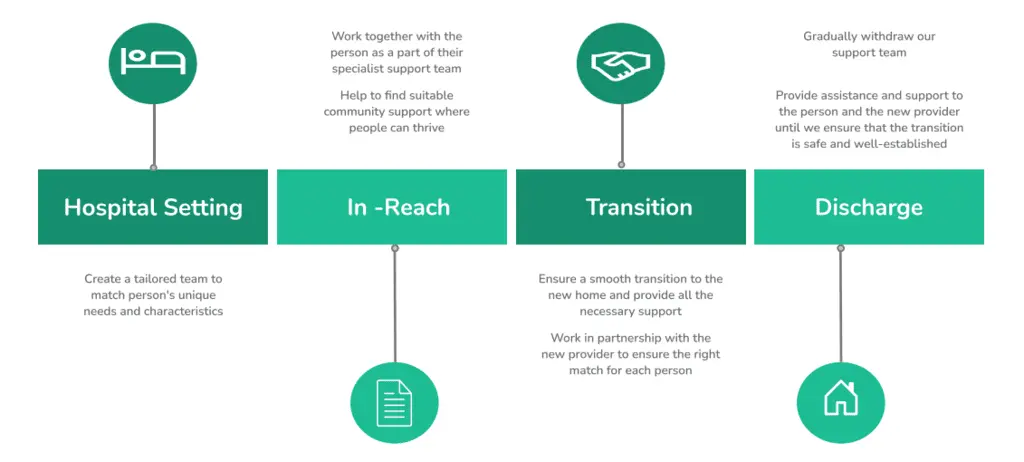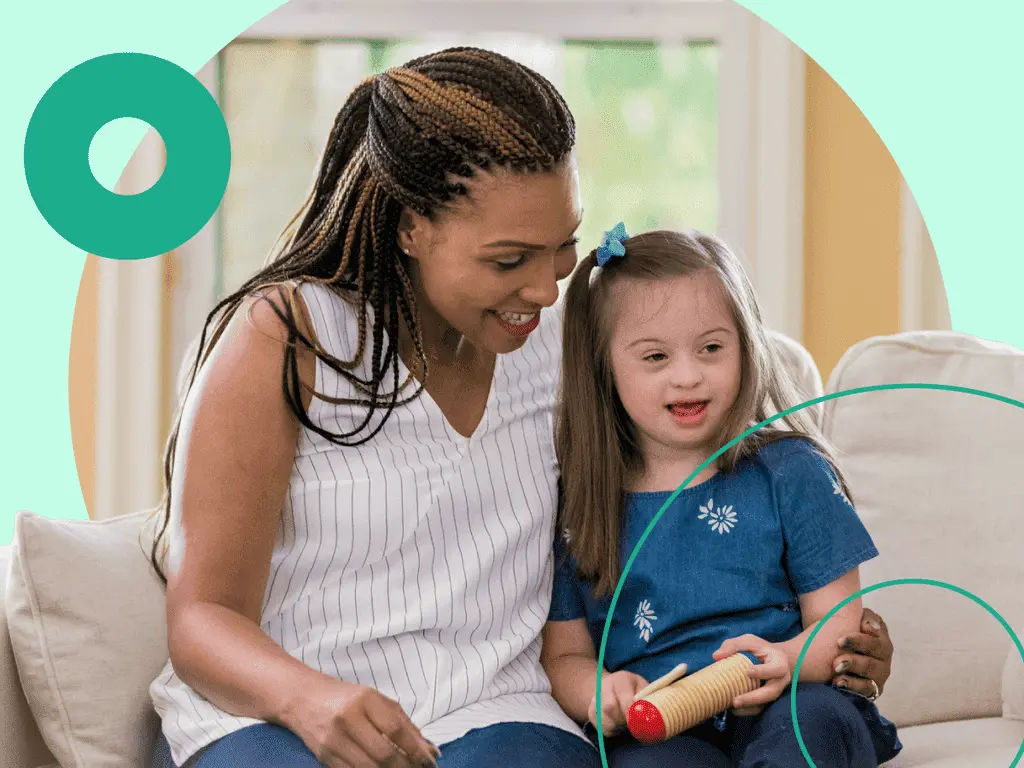Community transition services (CTS) are part of the Bridging Support Model, dedicated to reducing readmissions and delayed hospital discharges. We believe that with proper support, everyone can fully participate within their community, and no one should unnecessarily remain in a hospital.
This approach was introduced and tested by LD Network a few years ago. It has been successful in ensuring safe and effective hospital-to-community transitions for autistic people, people living with a learning disability and people with mental health needs.
Hospital Discharge Planning
Hospital-to-home transition begins with collaborating with commissioners dedicated to reducing delayed discharge. We then work closely with care recipients, families, and care providers to facilitate transitions through a method called Bridging Support.
The process begins with forming a temporary, wraparound team for the person while they are still in the hospital, offering proactive, holistic support that meets people’s specific needs. In many cases, this approach can significantly speed up people’s transition out of inpatient settings where they have been for far too long. This is particularly important for autistic people and people living with a learning disability, who are often detained in mental health units without a formal mental health diagnosis.

According to the Mental Health Act 1983, people can be detained in a hospital for assessment and treatment against their will only when they show a potential risk of harming themselves or people around them. However, due to a lack of appropriate community support, many autistic people and people living with a learning disability are detained in mental health units for years, which can have a highly negative impact on their physical and mental well-being.
In line with the Transforming Care agenda, we have developed safe and effective community transition services as part of our hospital readmissions reduction program.
The Impact of Effective Community Transition Support
The process starts with developing skilled and adaptable support teams dedicated to assisting a care recipient for as long as needed. CTS offers humanised support in various settings, including:
- Preventing crises at home: Providing support to people in their own homes, family homes, or current supported or residential accommodation can prevent crises from escalating into hospital admissions.
- Preventing further crises and escalation in hospital: Institutional settings, such as assessment and treatment units, often fail to provide the necessary support, leading people deeper into institutional systems and making discharge into the community even more challenging.
- Facilitating faster hospital discharges: People are often ready for discharge, but factors such as the inability to find a suitable care provider or challenges in recruiting a support team can delay this process.
Bringing People Home with Community Transition Support
The concept of community transition services was developed to form teams of like-minded and highly skilled professionals dedicated to helping people experiencing delayed discharge transition to community living. They understand the complex reasons for hospital admissions but recognise that many people are unnecessarily living in a hospital environment.
These teams are driven by strong values and are dedicated to supporting autistic people and people living with a learning disability to achieve full participation as citizens in their own communities.
To ensure a safe and smooth transition, we work closely with our internal multidisciplinary team consisting of Positive Behaviour Support (PBS) specialists, speech and language therapists, occupational therapists, and community psychiatric nurses (CPNs).
Our priority is to ensure people’s well-being and integration into community living and that the healthcare provider can continue providing support for as long as needed. We aim to prevent people from being readmitted to the hospital due to avoidable challenges and circumstances.
Community Transition Support in Steps:
- Get to know each person in the hospital setting, understanding their past, present, and future aspirations.
- Match each person with support workers from LD Network by considering their specific needs, along with shared interests and personality traits.
- Be actively present with the person in the hospital setting as part of their ‘inpatient’ support team, building a relationship and helping them make their voice, needs and preferences heard.
- Provide advice and support to the person and their family, assist in identifying suitable housing and support arrangements by working with a network of like-minded organisations, and collaborate with families and commissioners to arrange these.
- Help the person transition to their new home, providing all necessary support for as long as needed.
- Collaborate with the incoming care provider and allow time for person-centred matching, recruitment, and training, ensuring everyone involved is the right fit.
- Gradually reduce the support from the LD Network as the incoming care provider takes over, until everything is well-established and functioning smoothly.
- Remain available in the background with a team familiar, ready to provide support at short notice if any issues arise, offering stability and consistency as the person settles into their new life in the community.
Ensuring Effective Hospital-to-Home Transition
Community transition support involves a complex set of factors, including careful and structured planning and ongoing collaboration with local authorities, care providers and families. Our main priority is to ensure that the transition occurs as smoothly and naturally as possible and that every action and interaction is centred towards the person’s unique needs and well-being.
Consistent Care
Having a consistent team during transitions makes a significant difference. Based on our White Paper Publication responses, almost all participants reported that a lack of consistent teams is particularly challenging for people who struggle with routine changes, often leading to behaviour escalations and crisis situations. This can further lead to a risk of readmissions, emphasising the importance of consistent and coordinated support.
Collaborative Approach
We collaborate closely with various support networks, including family and friends, commissioners, social workers, hospital teams, the chosen care provider, and other health and social care professionals. By employing this multidisciplinary and collaborative approach, we gain a comprehensive understanding of each person’s unique needs, requirements, and aspirations. We allocate time and resources to create a support framework that ensures effective communication among all parties involved.
Rapid Response Interventions
Our Rapid Response team ensures people get the right support in place within 4-6 hours of the initial call, depending on the location. By addressing urgent needs and offering person-centred support, our service aims to prevent unnecessary hospital admissions and readmissions.
By coordinating with various healthcare professionals, support networks, and service providers, rapid response teams deliver person-centred care that addresses immediate issues and ensures people remain safe and well-supported in their own homes or community settings.
Personalised Care Plans
Personalised care plans in community transition services are designed to address each person’s unique needs as they move from hospital or institutional settings to home or community-based care.
With extensive experience from organisations like the NHS and the National Autistic Society, our therapy team is committed to helping people reach their full potential, leverage their strengths, and lead fulfilling lives.
Our approach is centred on person-centred support, prioritising collaborative care and decision-making while reducing restrictive practices.
Our therapy takes a proactive and comprehensive approach to discharge planning and transitional support, including:
- Functional assessment
- Cognitive behaviour assessment
- Environmental assessment
- Restraint reduction practices
- Specialised support strategies in Eating, Drinking & Swallowing
- Support with proactive, active, and calming strategies
- Support with Talking Mats, a visual communication system for people with communication difficulties
- Support for people with single and multiple behaviours of concern
- Support with multimedia and assistive technology (multimedia avatars, visual charts, video stories)
- Trauma-informed care
- Teletherapy
Role of Support Workers in Reducing Hospital Readmission Rates
Support workers are instrumental in reducing the risk of readmission by providing hands-on, compassionate care. By building trusting relationships with people and their families, support workers can spot potential risk factors early and address them before they become bigger concerns. They work closely with healthcare professionals, help aid transitional care interventions, and deliver personalised support. This person-centred approach prioritises people’s overall well-being and reduces the chances of unnecessary hospital readmissions.
Community Transitional Services with LD Network
Our community transition services effectively bridge the gap between hospital care and home-based support. With a holistic and proactive approach, we ensure people receive personalised care tailored to their specific needs.
We build strong partnerships grounded in trust, reliability, and consistency, facilitating a smooth transition to a home-like environment. We believe in protecting people’s human rights and helping them live fulfilled lives within their communities.
Reach out to us today for urgent transitional and crisis support, or to learn more about how community transitional services reduce hospital readmissions.












